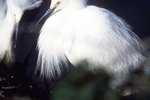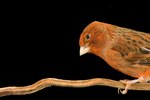
Male birds employ some very human-like strategies to attract the attention of the opposite sex. Some rely on flash, hoping to be seen as the most gorgeous guy around. Others put their faith in displays of skill and wealth. Still others turn to athletics, plummeting through the air with the wind whistling through their feathers. Love on the wing is a many-splendored thing.
Birds of Paradise
All 43 known birds of paradise species are native to the Indonesian island nation of Papua New Guinea, but many are so shy that ornithologists still don't know much about them. These birds aren't very big but make an impression out of all proportion to their modest size. The male Reggiana bird of paradise, the size of a small crow, has a yellow head, an emerald-green throat and a long train of russet-orange tail feathers. When he wants to attract female attention, he hangs upside down and extends his tail plumage upwards, a maneuver called the "flower display." The Astrapia's white tail feathers extend up to three feet behind his body and resemble fluttering ribbons.
How Birds of Paradise Got Their Name
You might think that birds of paradise were so named because of their otherworldly beauty but there's another reason. According to the British Museum, in the 16th century, European merchants began trading in the skins of Indonesian birds, their feet cut off and their feathers arranged to display their gorgeous plumage. Apparently, the absence of feet on dead birds led to the misconception that live ones didn't have any either, so must pass their entire lives gliding through the heavens. Today, we can still find evidence of this misunderstanding in the scientific name for the Greater bird of paradise, Paradisea apoda, which translates as "footless bird of paradise."
The Peacock's Tail: Here's Looking at You
Peacocks are related to pheasants and the most famous of the three species is the Indian peacock, native to India and Sri Lanka. This bird, also known as the common peacock, sports a train of iridescent blue-green tail feathers ornamented with markings that resemble gold, green and purple eyes. Each peacock can have 200 or more of these feathers, which grow to a length of 6 feet. When peacocks want to be noticed, they slowly raise their train over their backs and fan the feathers out until each side touches the ground. And just in case the object of their interest happens to be looking the other way, they can also produce a rattling noise by shaking their tail feathers. Females, called peahens, have drab plumage and no trains.
Bowerbirds: Master Architects and Illusionists
Bowerbirds of Australia and Papua New Guinea are the only animals known to create optical illusions to attract mates. Great bowerbirds, the largest of 20 species, have a life expectancy of about 30 years, but start working on building their love nests from age 5. When completed, these structures consist of an avenue about a foot and a half long, covered by a thatched twig archway. This opens onto a courtyard strewn with objects the architect hopes will impress females -- pebbles, shells, bones and colorful bits of plastic. When all is ready, the male announces that his honeymoon hotel is open for business, and females start to drop by. From one end of the tunnel, they watch their host brandishing his baubles at the other. But sightlines have been carefully crafted to make both the male and his treasures appear larger than life. The more skillful a bowerbird is at pulling off this trick of perspective, the more successful he is with the ladies.
Hummingbirds' Daredevil Dives
Too bad hummingbirds are so tiny that the spectacular courtship displays of some species easily go unnoticed by humans. When a male hummer decides to strut his stuff, he climbs up as high as 130 feet in the air, sets his sights on the girl of his dreams perched below and dive-bombs down towards her at warp speed. Just before he'd otherwise send her flying, he slams on the brakes by quickly spreading and closing his tail feathers, which interact with the air to generate loud fluttering sounds. The faster a hummingbird dives, the louder his aerial love song, which is unique to each male and produced only during courtship displays.
References
- The British Museum: Birds of Paradise
- Living on Earth: Birdnote: Birds of Paradise
- Animal Planet: Fowl: Peacock
- The Guardian: Bowerbird Builds a House of Illusions to Improve his Chances of Mating
- LiveScience: Bowerbird Bachelor Pads With Best Illusion Snag Mates
- Science Daily: Hummingbirds All A-Flutter During Courtship: How Fluttering Feathers Can Generate Courtship Sounds
- Science: Abstract: Aeroelastic Flutter Produces Hummingbird Feather Songs; Christopher J. Clark et al
Photo Credits
-
Purestock/Purestock/Getty Images




